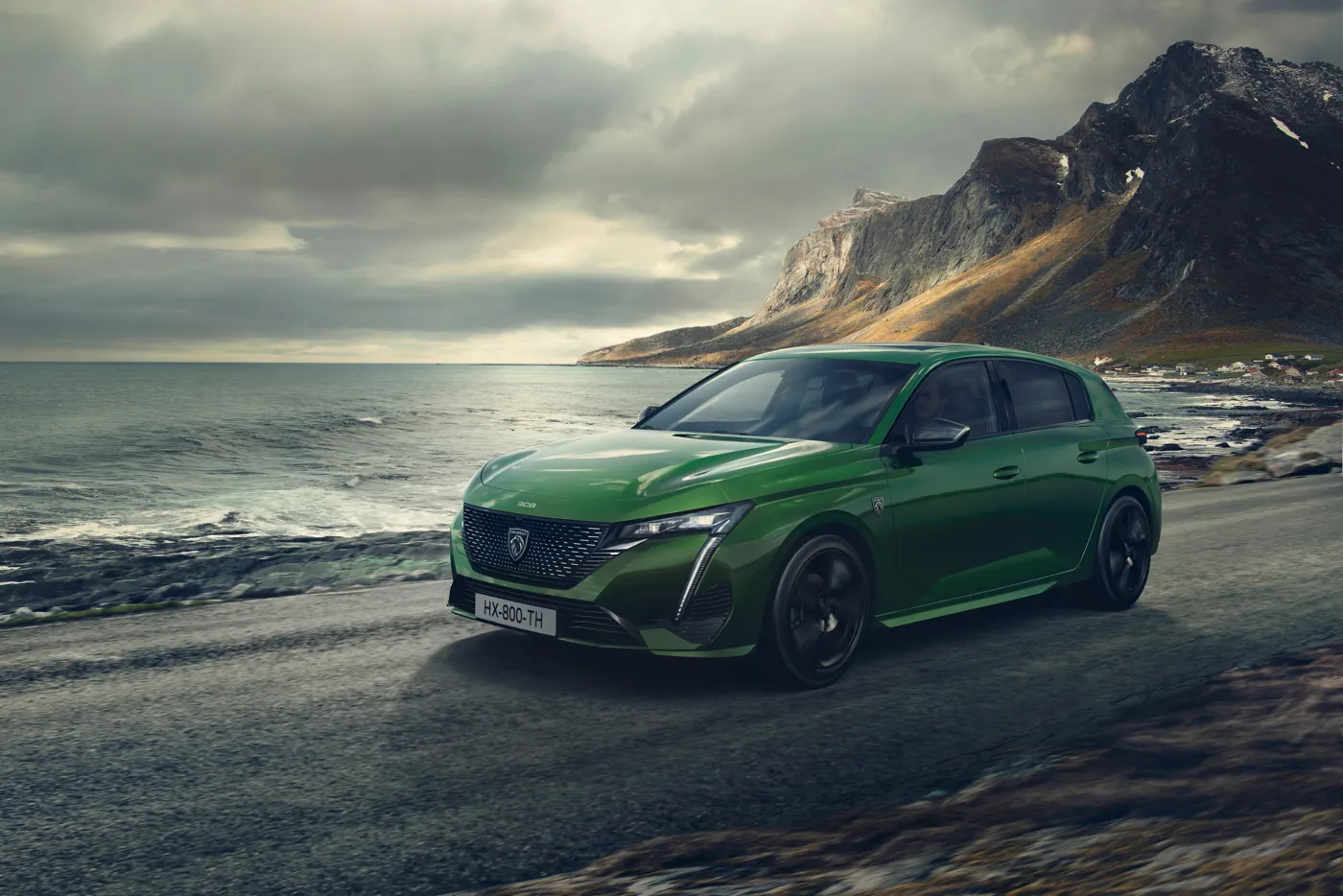Review
The previous Peugeot 308 was meant to represent the rebirth of the brand when it launched back in 2013, leading to the more driver-focused and sharper-looking models we know today, like the 3008 SUV and 508.
It didn’t resonate with buyers as well as the Ford Focus and VW Golf, however, leaving the C-segment hatch on the back foot.
This time around things are different. The latest 308 better represents the brand’s intentions to ride the coat-tails of the premium segment, offering a wider choice of powertrains plus more focus on ride, handling and desirability.
Perhaps that’s why the new car is the first to wear Peugeot’s new badge and why its launch will be supported by the roll-out of a re-brand of the car maker’s retail network.
Ful range of drivetrains
The 308 is also the first new Peugeot to be offered with petrol, diesel, plug-in hybrid and fully-electric powertrains, although the latter won’t be available until 2023.
So, is it any good? Well, on looks alone the new model scores highly. While it retains some of Peugeot’s signature styling details, like the ‘tiger paw’ rear lights and fang-shaped daytime running lights, the new 308 looks more purposeful and upmarket than any previous Peugeot.
On the inside, Peugeot’s unique i-cockpit – a layout that places the steering wheel beneath the instrument cluster – remains, which may disappoint some. We’ve criticised the set-up in the past for its non-conventional seating position and the same issues are apparent in the new car.
It requires a raised seating position, which goes against the car’s sporty pretensions, while the steering wheel must be adjusted to a lower-than-usual spot just to get a decent look at the dials.
Peugeot claims it has “millions” of satisfied i-cockpit users – whether the set-up hinders the 308’s chances against the Golf, in the UK market, remains to be seen.
Driving position aside, the rest of the 308’s interior could easily impress buyers of premium models such as the Mercedes-Benz A-Class.
A key change is the 308’s all-new infotainment system, which provides much crisper graphics and, crucially, a more responsive interface.
The majority of the car’s controls are housed within the touchscreen and are now much more straightforward to access.
The system, which is fitted across the range, can also receive over-the-air software updates.
A smaller touchscreen beneath the main 10-inch display provides shortcuts to key functions, which can be customised by the driver. It’s a cleaner solution than physical buttons and offers much improved usability.
On the road
The 308’s upmarket interior is complemented by high levels of refinement on the move. We were impressed at how little wind and road noise is audible while driving at motorway speeds.
There’s very little to criticise when it comes to driveability, in fact. The chassis is well balanced, giving a good degree of ride comfort along with competent handling.
UK buyers can choose from one petrol, one diesel and two plug-in hybrid engines from launch. A fully-electric model will also be offered, although there’s no word on specs yet. It’s also likely Peugeot will offer a hotter version of the 308 under its Peugeot Sport Engineered label.
The 1.2-litre petrol acts as the entry point to the range. It’s a three-cylinder unit, so needs to be revved quite hard to get moving. Still, it serves up 130PS and should be able to achieve closer to 50mpg.
Buyers seeking for a more efficient 308 might be tempted by the diesel, which offers the same 130PS power output as the petrol. Both come exclusively with an eight-speed automatic gearbox.
The diesel is more effortless at lower speeds, but struggles to accelerate at higher speeds.
Both feel underpowered and unrefined when compared with the hybrid models, however. Offered in 180PS and 225PS guises, the hybrid models use a 1.6-litre petrol engine and electric motor.
A 12.4kWh battery provides an official zero-emissions range of 37 miles.
The hybrids are more responsive, more efficient and more tax friendly, although prices start at £33,000 – some £9,000 more than the base petrol 308.
Despite carrying a weight disadvantage of some 300kg, the plug-in hybrid models don’t suffer dynamically. The extra kilos are not particularly noticeable and the overall package feels well resolved.
The new 308 represents the next chapter for Peugeot as it becomes a more premium-oriented brand within the Stellantis stable. And, i-cockpit gripes aside, it’s a mighty fine effort.
 Q&A
Q&A
JULIE DAVID, MANAGING DIRECTOR OF PEUGEOT UK
The car is launching with new badging and branding. What’s your strategy to get that across to new buyers?
We started on that journey in February of this year. That’s when we officially announced not just the new logo, but everything that goes with it from a brand identity perspective. So, we announced at the same time a corporate identity update for the retailers. They are now in the process of being updated and all sites will be complete before the car arrives in January. We’ve already transitioned our digital platforms to the new branding and that’s why it’s important our retailers are updated quickly, so the whole customer journey matches.
Do you expect that the 308’s market share will improve with this new model compared with the previous one?
The previous 308 was a great success for us and this third-generation car is really a step-up on that. You only have to look at it to realise what it’s going to do. I think the selection of powertrains will allow us to take more market share. In that segment it’s very compelling to have a car which is such a beautiful design, but equally one that offers a broad range of powertrains.
Why will UK buyers not be able to specify a manual gearbox?
We thought about it long and hard. If you go back a few years ago an auto in the UK was fairly rare, particularly in the C-segment. But, we’ve seen that really grow. The current balance for the market, we think, is around 50%. I think the adoption of all the PHEV technology and the BEV technology, means customers will increasingly just see auto as the norm. At the speed that the market is changing, the manual will be a lower and lower percentage of the overall market.
Which model do you believe will be the most popular?
Powertrain-wise, the mix from initial build allocations will be 20% hybrid, 50% petrol and 30% diesel. We think that will evolve pretty quickly, though, so the PHEV will get increasingly popular. Ultimately, our build mix will be dictated by the orders.
Has your launch plan been affected by the global component shortages?
We were planning to launch first week of December. It’s currently scheduled for the third week of January. So, yes, a small delay, but, actually, nothing unusual.
Factsheet
Price: £24,000 to £38,800
Engine: petrol, diesel or PHEV
0-62mph: TBC
Top speed: TBC
Gearbox: 8sp automatic
CO2 emissions: 25 to 131g/km













